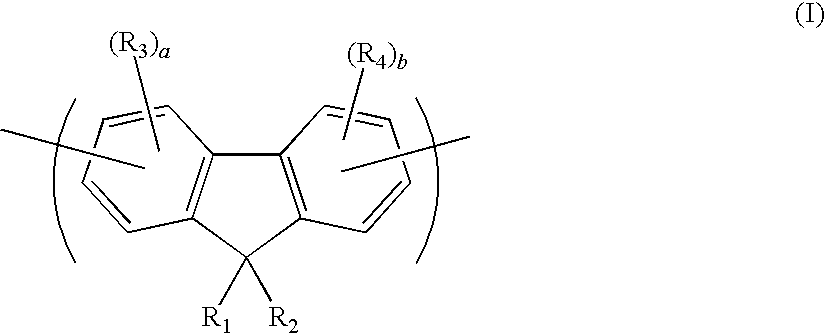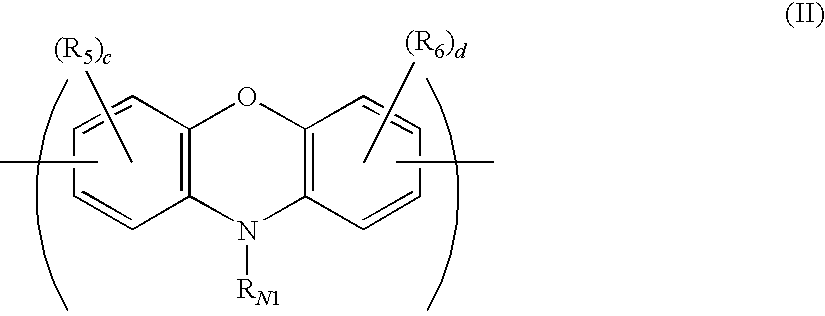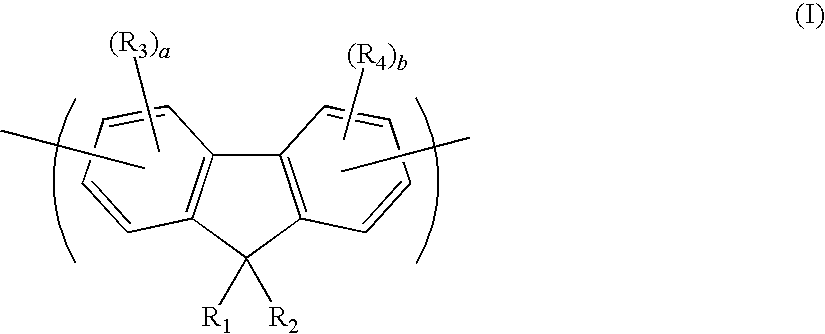Polymer compound and polymer light emitting device
a light-emitting device and polymer compound technology, applied in solid-state devices, discharge tubes/lamp details, light sources, etc., can solve the problem of insufficient luminance half-life period, and achieve the effect of prolonging the luminance half-life period
- Summary
- Abstract
- Description
- Claims
- Application Information
AI Technical Summary
Benefits of technology
Problems solved by technology
Method used
Image
Examples
synthesis example 1
Synthesis of N-octylphenoxazine
[0272]Under an inert atmosphere, phenoxazine (10.0 g), sodium hydroxide (21.9 g), tetraethylammonium bromide (0.37 g) and dimethyl sulfoxide (34 mL) were mixed, and the mixture was heated up to 80° C., then, 1-bromooctane (12.9 g) was dropped over a period of 50 minutes. Thenr the mixture was heated up to 90° C. and stirred for 1 hour, then, cooled down to room temperature. Then, the deposited solid was dissolved in 160 mL of toluene, and washed with water (100 mL) twice, washed with 1 N hydrochloric acid (100 mL) once, and washed with water (100 mL) three times, and allowed to pass through a silica gel column, and subjected to concentration under reduced pressure and drying in vacuo, to obtain 16.0 g of intended N-octylphenoxazine (purity: 99.4%).
[0273]1H-NMR (299.4 MHz, CDCl3); δ 0.89 (t, 3H), 1.15-1.47 (m, 10H), 1.65 (br, 2H), 3.45 (br, 2H), 6.31-6.88 (br, 8H).
[0274]LC-MS (APPI-MS (posi)): 296 [M+H]+
synthesis example 2
Synthesis of 3,7-dibromo-N-octylphenoxazine
[0275]Under an inert atmosphere, a solution composed of 1,3-dibromo-5,5-dimethylhydantoin (15.1 g) and N,N-dimethylformamide (15.8 mL) was dropped at room temperature over a period of 30 minutes into a solution prepared by adding dichloromethane (55 mL) to N-octylphenoxazine (15.0 g), and the mixture was stirred for 1 hour, then, stirred at room temperature for 6 hours. The resultant precipitate was filtrated and washed with methanol, then, dried under reduced pressure, to obtain 16.6 g of intended 3,7-dibromo-N-octylphenoxazine (purity: 99.7%). 1H-NMR (299.4 MHz, CDCl3); δ 0.89 (t, 3H), 1.18-1.46 (m, 10H), 1.59 (br, 2H), 3.38 (br, 2H), 6.29 (d, 2H), 6.73 (s, 2H), 6.88 (d, 2H).
[0276]LC-MS (APPI-MS (posi)): 452 [M+H]+
synthesis example 3
Synthesis of Polymer Compound
[0277]
[0278]Under an inert atmosphere, 2,7-bis(1,3,2-dioxaborolane-2-yl)-9,9-dioctylfluorene (1.37 g), 2,7-dibromo-9,9-dioctylfluorene (1.22 g), 3,7-dibromo-N-octylphenoxazine (0.18 g), palladium acetate (0.5 mg), tri(2-methylphenyl)phosphine (4.7 mg), Aliquat 336 (0.24 g, manufactured by Aldrich) and toluene (22 mL) were mixed, and the mixture was heated up to 105° C. Into this reaction solution, a 2M Na2CO3 aqueous solution (3.6 mL) was dropped, and the mixture was refluxed for 2.5 hours. After the reaction, phenylboronic acid (26.0 mg) was added, and the mixture was further refluxed. Then, a 1.8 M sodium diethyldithiacarbamate aqueous solution (20 mL) was added and the mixture was stirred at 80° C. for 2 hours. After cooling, the mixture was washed with water (25 mL) three times, with a 3% acetic acid aqueous solution (25 mL) three times and with water (25 mL) three times, and allowed to pass through an alumina column and silica gel column for purifi...
PUM
| Property | Measurement | Unit |
|---|---|---|
| Composition | aaaaa | aaaaa |
Abstract
Description
Claims
Application Information
 Login to View More
Login to View More - R&D
- Intellectual Property
- Life Sciences
- Materials
- Tech Scout
- Unparalleled Data Quality
- Higher Quality Content
- 60% Fewer Hallucinations
Browse by: Latest US Patents, China's latest patents, Technical Efficacy Thesaurus, Application Domain, Technology Topic, Popular Technical Reports.
© 2025 PatSnap. All rights reserved.Legal|Privacy policy|Modern Slavery Act Transparency Statement|Sitemap|About US| Contact US: help@patsnap.com



